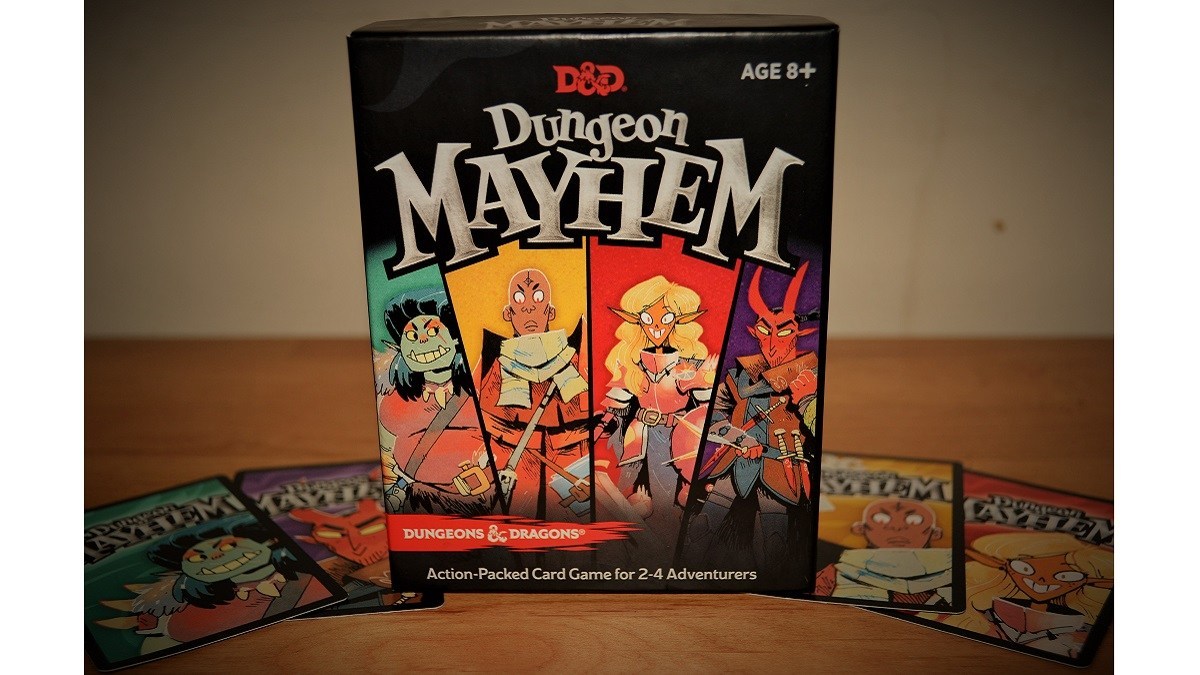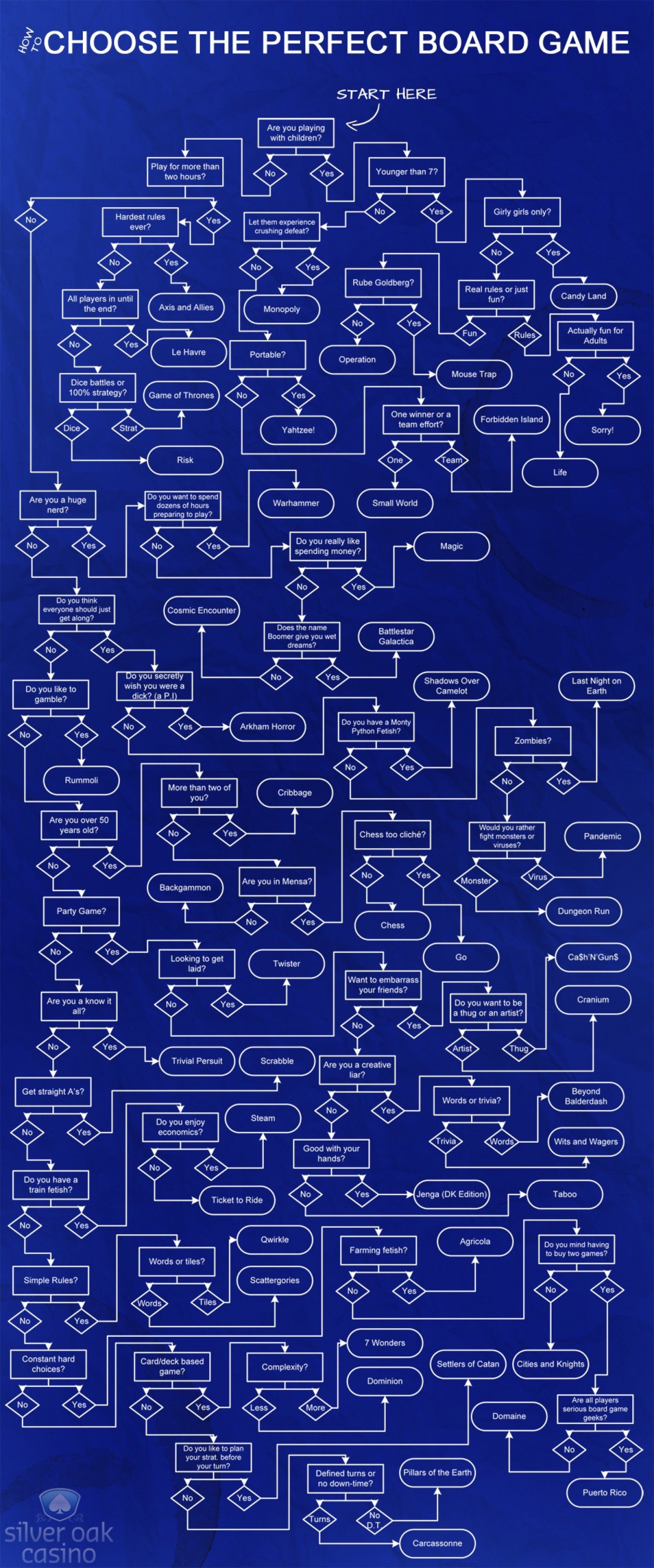Get ready to split the party with Dungeon Mayhem, a game that pits ally versus ally to see which Dungeons & Dragons hero is the best.
What Is Dungeon Mayhem?
Dungeon Mayhem is a deck-based competitive card game for 2-4 players aged 8+ and can be played in 10 minutes. It’s a turn-based free-for-all Battle Royale that sets player against player in a bid to see who will be the last hero standing. More than loosely based on Dungeons & Dragons, players take on the role of one of four unique adventurers, using classic skills and abilities from The World’s Greatest Roleplaying Game.
What’s in the Box?
- 4 hit point trackers
- 4 hit point tokens
- 4 reference cards
- 16 damage tokens
- Four 28-card decks
- Instruction leaflet
While not in the traditional D&D style, the artwork for Dungeon Mayhem is attractive and consistent, and the cartoon-y style will appeal to younger players, while still retaining enough of the essence and look of Dungeons & Dragons for those more familiar with the brand. Unlike some of the previous editions of the D&D Monster Manual, parents need not worry about exposing younger children to half-naked succubi or inappropriate imagery.
The quality of the cards is what you would expect from the company behind Magic: The Gathering: durable, glossy, and well printed. However, the tokens, only made from a couple of layers of thin cardboard, are likely not to last as long. A couple of mine have already started to show signs of wear with splitting after only a handful of games.
How to Play Dungeon Mayhem
In Dungeon Mayhem, players play as one of four different characters, with each character’s tricks, gear, and skills denoted by a deck of cards.
The characters represent four of the classic base classes from D&D: Barbarian, Wizard, Paladin, and Rogue. Each character comes with a selection of attack and defense options based on the flavor of their class. You can choose from:




The Goal
The goal is to defeat all the other players and be the last hero standing. On their turn, players have both offensive and defensive options to choose from and the aim is to whittle away your opponents’ hit points while ensuring you stay alive.
The setup for Dungeon Mayhem is very quick and straight forward, and is the same if playing with 2, 3, or 4 players.
First, each player chooses a character and collects the corresponding deck, hit point tracker, and reference card, and places these on the table in front of them.
Then each character token is placed on the number 10 in their hit point tracker to represent their starting hit points. When you get to zero hit points, your hero is dead and you are out of the game.
Each deck is then shuffled and placed next to the hit point tracker and everyone draws three cards from their deck. Now you are ready to play.
Taking a Turn
A turn is made up of 4 stages, and in keeping with tradition, the youngest player goes first.
First draw a card.
Then play a card from your hand and resolve the actions, sometimes you can play more than one card on your turn, depending on what the first card says.
Then, once you’ve played your card(s), place all played cards no longer in play in the discard pile. A card may still be in play if it is a defensive card that has one or more shields in the top left corner. Then once you have finished, play passes to the player on the left.
Actions
In Dungeons & Dragons, the things you can do on your turn are called actions, and in Dungeon Mayhem there are five types of cards which each represent a different type of action: Attack, Defense, Draw, Heal, and Play Again. Some cards have multiple symbols on them, meaning you can do more than one type of action, and each character also its own unique Mighty Powers which are special abilities that are detailed in the text on the card.

When you play an attack card you choose an opponent and deal damage equal to the number of crossed swords on the card. Once you play an attack card it is immediately placed in your discard pile.

The amount of damage they can take is equal to the number of shields on the card. These cards stay in play until they have been destroyed and each character can have more than one defense card in play at once.

You can draw as many cards as signified on the card, sometimes up to 3 at once.

When you play a healing card you regain an amount of hit points equal to the hearts on the face of the card, up to a maximum of 10. You cannot heal shields.

They allow you to play additional cards, one for each lightning symbol. The extra cards you play can also be Play Again cards and your turn doesn’t end until you have played as many cards as the symbols request. If playing a Play Again card means you run out of cards in your hand, you must draw 2 more cards from your deck and keep playing until you have played the requisite number of cards.
Ending the Game
Each player begins the game with 10 hit points and they keep track of their vitality by moving their character token along the hit point tracker. If you reach zero hit points, your hero dies. The game ends when there is only one player left alive.
There are times when a card, like the Wizard’s Fireball, could potentially knock out multiple players simultaneously. If this happens and there are no players left in the game, then it’s a tie—and you have to battle again to see who will win.
So, Is Dungeon Mayhem Any Good?
I really enjoyed Dungeon Mayhem. It’s fun, quick, and easy to play and, having tested it on both adults and children, I can say that almost everyone I played with would agree. It’s simple and clear enough for young players to pick up quickly, whilst dynamic and varied enough to keep more senior players entertained. Especially if they are already familiar with Dungeons & Dragons.
The spells and actions for each character retain enough of a connection to the lore of D&D for it to be satisfying for aficionados, as well as delivering a solid foundation for anyone looking for ways in which to share Dungeons & Dragons with their kids. In one round the wizard can cast Magic Missile, while the barbarian Rages and the paladin attacks with Divine Smite, as the rogue retaliates with a Sneak Attack.
Gameplay is smooth and easy to follow and having the special abilities means that your choice of class does make a difference to your strategy. They have balanced the abilities for the heroes well, so there isn’t one class which is weaker or more powerful than the others. In the 10 or so games that I played, no one particular character seemed to win the most, although the wizard and rogue seem to be the more popular choices.
My only gripes with Dungeon Mayhem are that only four out of the 12 playable classes from D&D are present. I would love to see the rest of the canonical classes added at some point. Perhaps there are two expansions still to come?
Although seemingly very simple, there is a certain amount of flexibility and versatility to Dungeon Mayhem too. When we played a two-player game, we split the character decks up and created multi-class heroes—just like in D&D—this added a whole new dimension to the game and was just as fun, if not more so, as we could pick and choose which spells and abilities to play with.
Overall I would recommend Dungeon Mayhem to anyone looking for quick multiplayer card game with a hint of Dungeons & Dragons and enough newness to set it apart from other combat based games. There are certainly worse ways to spend $15.
![]() To subscribe to GeekDad’s tabletop gaming coverage, please copy this link and add it to your RSS reader.
To subscribe to GeekDad’s tabletop gaming coverage, please copy this link and add it to your RSS reader.
Click here to see all our tabletop game reviews.
Disclosure: GeekDad received a copy of this game for review purposes.






